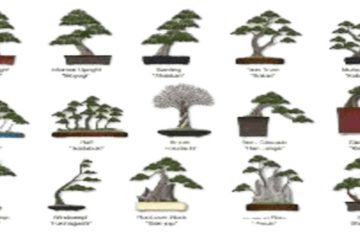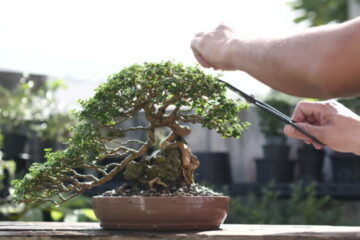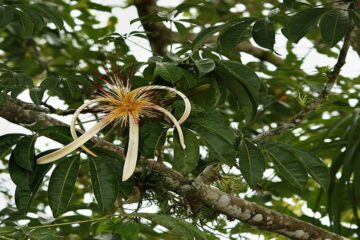Flame tree bonsai is also known as flamboyant or royal poinciana or Delonix regia due to its natural growth in tropical or semi-tropical regions. This bonsai species is very popular among bonsai lovers because it looks green when young and blood-red in the flowering stage. And its umbrella-shaped style enhances your interior beauty.
But, if you struggle to take care of it properly, the plant may be insufficient or even withered, which may disappoint you. Don’t worry, here we cover everything from seeding to flowering plants. And you will gain a deeper understanding of how to care for your Delonix regia bonsai.
So, let’s put on your shoes to enjoy a pleasant journey into the world of bonsai.
Flame Bonsai Tree Overview
Content Overview
- Neck Name – Glorious Flame Tree
- Inventor – Wenzel Bozer (botanist)
- Year of invention – 1820
- Invented – Europeans
- Country of origin – Madagascar, Africa
- Origin of the name – two Greek words (“delos”, meaning clear and “onyx”, meaning claw-like
- Region or climate suitable for growth – tropical or sub-tropical areas
- Seed length – 60 cm
- Tree length – up to 40 feet from root
- width – up to 70 feet from the crown
- Soil Requirement – Minimum soil
- required – high pruning
- Types of leaves – like pinetails and ferns
- Preferred Temperature – 10-20°C or 50-68°F
- Weather that cannot withstand – cold weather or low temperature
- Display Style – Ornamental
- Growing season – summer
- Flowering Season – Spring to Summer
- Flower color – blood red or similar to Hibiscus rosa-sinensis
- Blooming period – several months
General information about Delonix, or Flame Tree Bonsai
The seed pods can be 12-24″ (30-60 cm) long and can look out of proportion on the flame tree bonsai if you let them develop. The leaves are double and resemble fern leaves. The bark of the Flame Tree Bonsai is gray-brown, smooth on young trees and becomes rough with age.
The tree grows rapidly, can reach 10 m (33 ft) high, and has a natural umbrella shape that should also be noted when styling the flame tree as a bonsai.
In tropical climates the tree is more or less evergreen while It will become deciduous in cool subtropical regions. The flame tree does not tolerate frost and needs winter temperatures between 50°F (10°C) and 68°F (20°C). If you need help identifying your tree, our bonsai tree See the identification guide.
Read More :The Ultimate Guide How to Shape a Bonsai tree
Flame Tree Bonsai Care Guide
A quick overview of flame bonsai is not enough. Now you may feel the need of a thorough instruction of careful instructions from time to time to level your confidence in cultivating this bonsai. The art of understanding the proper process of caring for your tree leads to an aesthetic and gorgeous structure.
Ideal placement
The flame tree bonsai is a summer-friendly bonsai species, and you need to place it in a sunny and airy place where it gets proper sunlight. That means a south-facing window, balcony or patio garden is the perfect place to place flame tree bonsai. Flames will grow rapidly below 10°C or 50°F at night and below 20°C or 68°F during the day.
Flame tree bonsai cannot tolerate cold weather and low temperatures. So it is essential to keep the plant in the right place and maintain the right temperature.
If you live in a subtropical area, you should not face any challenge to maintain the required temperature during the day.
But what to do at night?
Maybe you’re thinking about artificial grow lights. Yes you are right. If you face the challenge of maintaining the right temperature level at night, you can use LED grow lights. And the light gives you the opportunity to meet the temperature your plants need. You can use multimeter to measure the temperature and adjust the temperature of the light. It’s simple.
Flame tree bonsai watering
The water needs of the flame plant will vary seasonally and its pH tolerance range is 4.5 to 7.5. So the plants should be watered according to the season and soil conditions.
The sun burns and generates a lot of heat in summer. So plants need more water in summer than in winter. During this season you need to water the plant regularly so that the plant can make food and transfer it to its branches, branches and leaves.
Do not water the plant after the soil is too dry or if the soil is wet. Carefully test the soil moisture before watering.
In winter, you can determine an interval watering schedule by monitoring your plant’s water needs. So you can avoid the problem of root rot due to over-watering. To learn more about bonsai watering checks How often do you need to water your bonsai?
Fertilizer instructions
Applying the right fertilizer at the right time will increase the growth of your bonsai. You will find 2 types of fertilizers in the market: solid fertilizers and liquid or spray fertilizers. You can apply both based on your preference, bonsai growth stage and availability.
Fertilizer application time interval
- Solid fertilizer – every 4 weeks
- Liquid Fertilizer – Every week
Whatever fertilizer you choose, be it solid or liquid, you must ensure a balanced content of NPK. The correct ratio of nitrogen (N), phosphorus (P), and potassium (K) will promote healthy and vibrant flowers during the blooming stage.
Read More :The Ultimate Guide To Best Bonsai Tree Fertilizers
Trimming and wiring
The beautiful umbrella shape of your flame bonsai will not come on its own. You will need to prune it, and this tree species can tolerate heavy pruning.
Spring is the best season for flame tree bonsai pruning. Because in this season the tree has no leaves and looks like a bare branch. Which means you can easily reach the branches you need to prune.
Initially, you should select trailing and strong branches for pruning. You should also cut off damaged and dead branches to ensure proper plant growth. You can wire some stems to bring them to your desired shape without pruning.
It does not end here. You may need to prune the tree consistently in the summer. Click here for a step-by-step guide on how to shape a bonsai tree.
Repotting
As the soil of the flame tree bonsai grows, it loses its ability to provide nutrients. Also, due to the proper growth of plants, the spaces become smaller. As a result, the plant faces a shortage of nutrients and has insufficient space to grow.
In this situation, repotting the tree is the best option to solve the problem. After repotting, the flame plant will receive ample space and balanced nutrition to thrive.
Right time of repotting
By checking the growing stage and condition of the plant, you can repot it every six months or 12 months. And spring is the best season for repotting. Expert bonsai gardeners advise that pruning is the right time to reestablish the tree. Also, you need to consider the root system, structure and root health before repotting. Don’t hesitate to prune dead roots if necessary.
Soil preparation process for repotting
This bonsai grows best in slightly acidic soil. So if you can handle kanuma, add something to the soil to regenerate them. See How to Repot a Bonsai for details on this process.
Propagation
For flame tree bonsai germination or propagation, you must collect seeds from mature seed pods (check Amazon flame tree bonsai seed prices). After that, you need to keep it in warm water for a few days to prepare it for planting. After that, you need to plant the seeds in the soil, maintaining a temperature of 20 degrees Celsius or 68 degrees Fahrenheit. After 3 weeks, you will see a seedling through the soil.
Pests and Diseases
Scale irritants or flame tree bonsai can irritate plants, especially in winter. In this case try to scratch them manually and use a specific insecticide. Can also be shoot borers or caterpillars. Over-watering or too cold conditions can cause root rot. Then repot the plant, cut off damaged roots and plant in fresh, well-drained soil. Try to improve the condition of your tree. For more detailed information on these techniques, see our Bonsai Tree Care guideline articles.
Conclusion
So, finally, we’re down to the last few words of our comprehensive guide to flame tree bonsai.
Growing bonsai is always exciting, fun, enjoyable and entertaining. Bonsai can be a great joy to watch when its attractive and colorful flowers bloom. So follow our guide and enjoy your bonsai gardening experience.If You any question please comments me.



